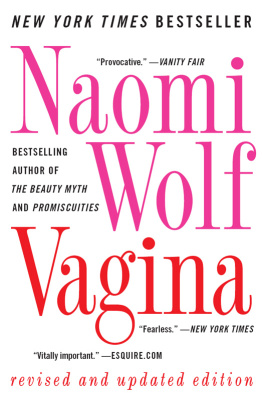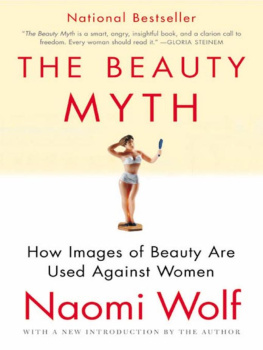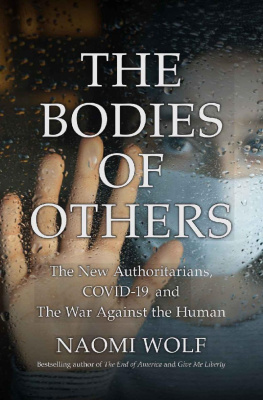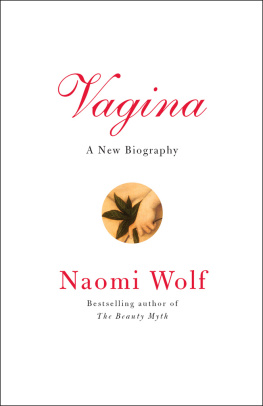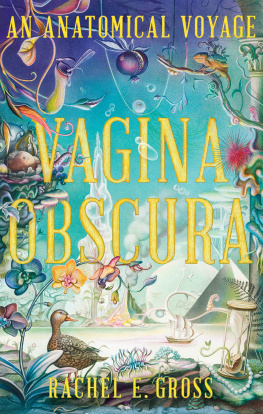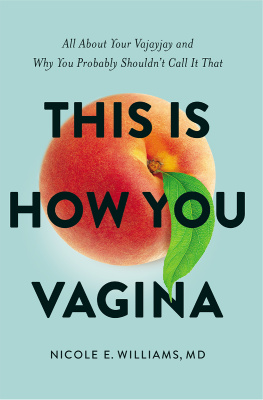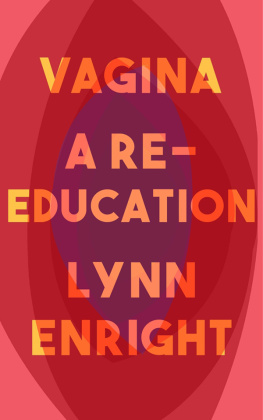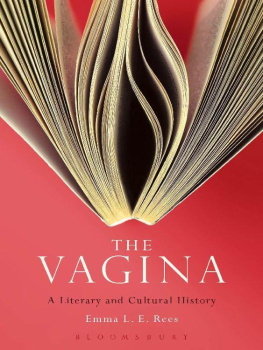FOR A.
How strange and awful it seemed to stand naked under the sky! How delicious! She felt like some new-born creature, opening its eyes in a familiar world that it had never known.
KATE CHOPIN, THE AWAKENING
Contents
T his book could not have been written without the help of many others, especially the many distinguished scientists, researchers, counselors, and physicians whom I interviewed. They shared their time and expertise generously in order to inform nonscientists about womens health and sexuality. In order of their appearance in the book, I am very grateful to Dr. Deborah Coady of Soho OB/GYN in New York City; Nancy Fish of the same practice; Dr. Ramesh Babu of New York University Hospital; Dr. Jeffrey Cole of the Kessler Center for Rehabilitation in Orange, New Jersey; Dr. Burke Richmond of University of Wisconsin School of Medicine and Public Health, Madison, Wisconsin; Katrine Cakuls in New York City; Dr. Jim Pfaus of Concordia University in Montreal, Quebec; medical writer Dr. Julius Goepp; Dr. Beverly Whipple; Dr. Barry Komisaruk of Rutgers; Dr. Pooja Lakshmin of the same Rutgers lab; and Dr. Basil Kocur of Lenox Hill Hospital in New York City. Interviewing the scientists has been extremely inspiring in terms of witnessing their commitment to advancing the understanding of womens sexuality, and interviewing the physicians has been similarly inspiring in terms of witnessing their sincere dedication to advancing the treatment of womens sexual health. Many of these scientists and physicians read the manuscript in various versions, and I thank them wholeheartedly again for their time, which has many demands upon it, and for their valuable feedback. Any errors, of course, are my own.
I am grateful to Caroline and Charles Muir and Mike Lousada, who took time to inform me about the history and practice of Tantra.
Warm thanks are due also to the many women and men who shared their personal stories, whether under their own names or with pseudonyms.
I am deeply indebted to my brilliant editors Libby Edelson and Daniel Halpern of HarperCollins and Lennie Goodings of Virago. I could not have had more perceptive, challenging, and insightful readers and commentators. Thanks also to Michael McKenzie, Zoe Hood, and Danielle Holke. The copyeditor, Laurie McGee, was meticulous and patient. Rashmi Sharma provided admirable help with research materials. John and Katinka Matson and Russell Weinberger of Brockman, Inc., my agents, also read versions of the manuscript and provided much-appreciated commentary.
My deepest gratitude, as always, is for my familyparents, partner, and children.
T he central theme of this book, though it is also about the intellectual and cultural history of the vagina, is that recent neuroscience has confirmed a powerful and important brain-vagina connection. My analysis of key hormones and neurotransmitters involved in female sexual pleasure, which, I argued, have a direct causal relationship to female confidence, creativity, and connection, led me to hypothesize that it is because these substances are empowering that female desire and even female sexual anatomy have been targeted for millennia.
It is true that I offer here a hypothesis about women and their sexuality in society, based on a relatively new body of data about hormones and neurotransmitters: specifically, dopamine, opioids/endorphins, and oxytocin. But I would challenge the notion that because the data are fairly new, it is premature to hypothesize about the connection between the neuroscience of womens sexuality and their political and social empowerment.
Using such methods to make connections between scientific data and the lives of women is not a new technique for me. I have been using this method of analysis for the bulk of my career, dating back twenty-five years. And the main hypotheses about women and society that I have drawn in the past, based on medical and scientific data, have proved true time and again.
In my 1993 bestseller, The Beauty Myth, I looked at the medical data on the physiology of starvation and its effect on the mind. By analyzing the biology of calorie restriction, and its effect on consciousness, I hypothesized that the emerging ideal for women of extreme thinness was a socially mediated way to biologically suppress energy, defiance, and resistance in young women who were otherwise the heiresses of feminism. Anorexia had primarily been seen as a purely psychogenic illness, with no biological component. But the wide adoption of my analysis of the biology of starvation, and starvations addictiveness, helped to hasten the push to treat anorexia as an illness that victims can catch physiologically from the act of dieting, and that they must struggle to overcome both psychologically and physiologically.
In Misconceptions, a bestseller published in 2001, I investigated scientific and medical data in order to examine how stress affects labor and lactation. I hypothesized that traumatic birth interventions escalate maternal stress, and that this stress heightens the need for cesarean sections and other interventions. I made this case at a time when those views were very marginal. But the data on stress, interventions, and their relationship to childbirth complications have since been much bolstered, and the books core insight is now widely accepted and implemented by mainstream ob-gyns, midwives, and hospital policy makersas well as new moms.
In an essay I wrote for New York magazine, The Porn Myth, published in 2005, when the only medical data available were anecdotal, I warned readers that this anecdotal evidence showed diminished sex drive in otherwise healthy men who were becoming addicted to pornography. I received a flood of worried letters and emails from men confirming this hypothesis. Now the hard data are in, and the neurobiology of porn and addiction (and treatment) is much better understood and documented. The mechanics of what one young man who wrote to me called the kink spiralthe desensitizing effect of porn, which has a neurobiological basisis now part of mainstream thinking.
My hypothesis in these pagesthat female sexual pleasure empowers women biologically (and thus also psychologically, and politically), and that the sexual traumatization of women also measurably impacts the brain and body in newly identified wayshas been confirmed in the past year anecdotally by hundreds of readers communications, as well as by updates from some of the practitioners in emerging fields related to this area, such as obstetrician/vulvodynia specialist Dr. Deborah Coady and her colleague Nancy Fish Bravman. Pioneers in the field of the new neuroscience of the brain-vagina connection, notably Dr. Beverly Whipple and Dr. Barry Komisaruk, have very kindly directed me to additional important data relating to this hypothesis, as well as to significant new insights from their own work, which I have incorporated into this edition to further expand our understanding of this connection. Dr. Pooja Lakshmins recent Rutgers work on oxytocin adds to this picture.
It is interesting to me, as a cultural critic, that The Beauty Myth, Misconceptions, and my essay The Porn Myth all used the same method and the same argument as Vagina: A New Biographythat is, the method of mapping medical and scientific data against womens social experience, then making an argument about the power of the body to affect the mind, and exploring the political implications of that outcomeand were received with little controversy. I was not charged with reducing women to their waist size or reducing women to their uteruses in the wake of those arguments, so parallel to this one. But, fascinatingly, when I applied this long-established, tried-and-true method to a subject that involves womens power and pleasure rather than their subjugation, the same method became highly controversial.

